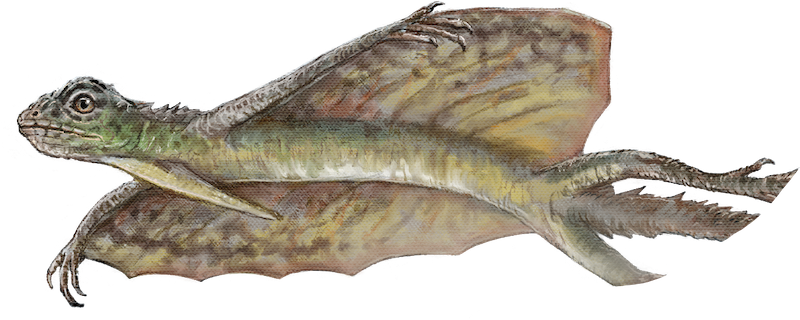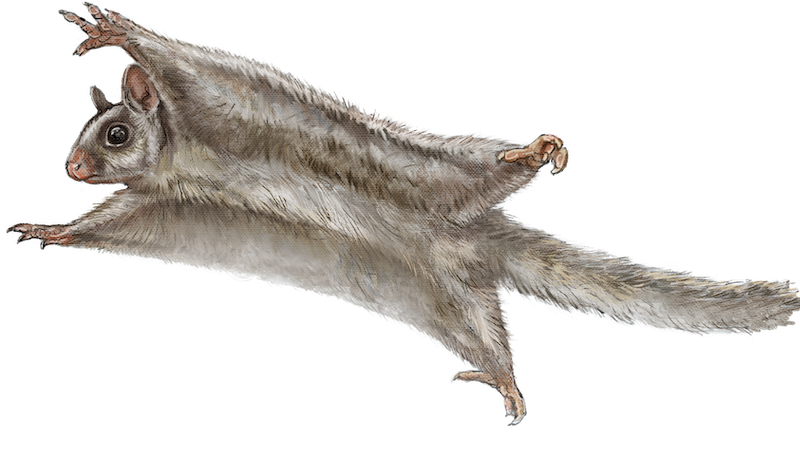Faux Flyers
Falling with Style
Flying isn’t just for the birds. Aside from other creatures that travel by true flight, such as bats and insects, many creatures take to the sky in a type of faux flight. The unique varied biological features that allow typically terrestrial organisms to become airborne are a marvelous testimony to the intricacies of God’s creation.
Colugos

Southeast Asia
Up to 475 feet (145 m)
The colugo achieves flight by using a membrane called a patagium. However, unlike other gliding mammals, the colugo’s patagium stretches beyond its arms and legs to encompass its hands, feet, and tail, giving this mammal the appearance of being covered in a furry blanket. Though the colugo’s extensive patagium makes it the most skilled glider in the mammal family, it renders the colugo virtually helpless on the ground. For this reason, the colugo spends most of its time foraging and gliding among the trees. Because the colugo is not a marsupial like feathertail gliders and sugar gliders, it does not have a pouch to carry its young. Instead, the mother curls up her tail to create a temporary pouch out of her patagium to protect her baby during flight.
Flying Snakes
The flying snake (Chrysopelea) is the only limbless vertebrate with the ability to fly. It accomplishes this impressive feat by flinging itself from a tree branch and then flattening its body to nearly twice its normal width. This modification increases drag, or air resistance, effectively slowing the reptile’s descent. The snake moves through the air in an undulating motion to further increase the air pressure beneath its body and allow it to guide its trajectory in “flight.”

South and Southeast Asia
Up to 300 feet (100 m)
Draco Lizards

South and Southeast Asia
Up to 200 feet (61 m)
The Draco lizard, nicknamed flying dragon, may not be able to achieve true flight or breathe fire like its namesake, but its gliding mechanism is certainly legendary. With its slender body and camouflaged skin, this lizard doesn’t look much different from a gecko when it’s resting. But when it takes to the sky, a set of 5–7 elongated ribs extend from the sides of its body, stretching out the folds of skin between them like wings and giving the Draco an epic, dragon-like appearance. As it glides, the lizard grasps its makeshift wings with its arms to stabilize and direct its flight. When the Draco lands, it retracts its ribs back into its body, as if its mind-blowing flight never happened.
Feathertail Gliders

Australia
Up to 92 feet (28 m)
The feathertail glider, also known as the pygmy gliding possum, is the smallest gliding mammal in the world. Similar to flying squirrels and sugar gliders, the feathertail glider achieves flight by relying on its patagium that extends between its front and back legs. Unlike the fluffy tails of most other gliding mammals, the feathertail glider’s slender tail is fringed with long, stiff hairs that resemble the barbs of a feather. This tail acts as a sort of rudder to guide the glider through the air.
Japanese Flying Squid
The Japanese flying squid can propel itself up to 100 feet (30 m) into the air from underwater. After drawing water into its mantle (the fleshy “hat” that covers its body), the squid then contracts its muscles, forcing water back out of the mantle through its siphon (a tube at the base of its head). This creates enough water pressure for the squid to propel itself out of the water. Squids use this same method to travel between two points underwater, but they can accelerate up to five times faster in the air, making their aerial journeys a bit more impressive. Once in the air, the squid often glides close to the water’s surface, using the membrane between its arms to create drag and periodically flapping its fins for control.

Northern Pacific Ocean
Up to 100 feet (30 m)
Answers Magazine
July–September 2023
The undercurrent of Critical Race Theory is tugging students away from God’s Word. How should parents respond?
Browse IssueRecommended Resources

Answers in Genesis is an apologetics ministry, dedicated to helping Christians defend their faith and proclaim the good news of Jesus Christ.
- Customer Service 800.778.3390
- Available Monday–Friday | 9 AM–5 PM ET
- © 2025 Answers in Genesis





